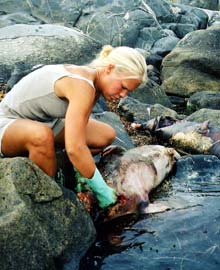European Seal Plague May Threaten Population Survival

A researcher gathers samples from this summers outbreak along the Swedish west coast. <br>Photo by: Tero Härköne, Göteborg University.
2002 Outbreak May Claim 10,000 Harbor Seals
Scientists from Göteborg University in Sweden and the Woods Hole Oceanographic Institution (WHOI) report in an upcoming issue of the journal Ecology Letters that the 2002 outbreak of phocine distemper virus, or PDV, in European harbor seals may reduce the population by more than half and that future outbreaks with similar characteristics would significantly increase the risk of population declines. Their findings are the first epidemiological data reported on the 2002 outbreak, which is still underway, and may help predict the recurrence of the outbreaks and the impact on the long-term growth and survival of the European harbor seal population.
The current outbreak of PDV, also called the seal plague, was first identified in May 2002 when large numbers of dead seals were reported in Denmark. By mid-September the number of deaths had passed 6,000 in Denmark and had spread to the Baltic, the Wadden Sea and East Anglia. A 1988 outbreak from the previously undescribed virus spread from Denmark to Sweden, the Netherlands and then to England, Scotland and Ireland, in what is now believed to be the largest such event in any marine mammal population. Within seven months all major European harbor seal colonies had been affected by the virus, although the death rate varied from 15 to 58 percent among regions. The virus is thought to have been introduced to the European harbor seal population by migrating harp seals observed in Danish waters in 1987 and 1988. No outbreak of the virus had been reported since 1988 until this year.
Biologist Hal Caswell of WHOI, one of the authors of the report, and his colleagues used mathematical models based annual aerial surveys of populations and collections of dead seals in an intensive sampling program along the west coast of Sweden. They compared the 2002 findings to information obtained in the 1988 outbreak, and although the 2002 outbreak is still underway, predict that it will have similar impacts on the harbor seal population.
Study authors Karin Harding and Tero Härkönen of Göteborg University and Caswell of WHOI have begun to explore how the frequency and severity of these seal plague outbreaks affect population dynamics. They note that while it is generally believed that survivors develop a life-long immunity to PDV, they estimate that no more than seven percent of the current European harbor seal population is made up of survivors of the 1988 outbreak and therefore believe immunity plays almost no role in the 2002 outbreak. The authors predict that 10,000 seals will die from PDV in 2002 in Sweden and Denmark alone.
“This is, to our knowledge, the first study where the consequences of PDV outbreaks have been evaluated in terms of quasi-extinction,” the authors say. “The risk of a catastrophic decline of the population is small, but other factors, like hunting, will increase that risk, as will more frequent PDV outbreaks.”
The authors note that PDV is spread by coughing, with the level of exposure to the virus dependent on how much contact there is between individuals. For example, colonies infected in late autumn, when seals spend less time on land, experienced low mortality rates while those infected in the summer when seals spent more than on land, had much higher mortality rates.
Noting that the 2002 PDV outbreak started more than a month later than the 1988 event, the authors predict that mortality rates will be more than 50 percent in the Dutch Wadden Sea and the southern Baltic region, with lower mortality rates in the German and Danish parts of the Wadden Sea, and substantially lower mortality rates in England, Scotland and Ireland. They predict the outbreak will subside in late November.
“PDV is now a recurring risk to harbor seal populations, they note. “It is important to begin to develop more elaborate population models that include age and sex structure, seasonal behavior, and other factors to help us monitor this situation.”
The study was funded by the Swedish Environmental Protection Agency, US. Environmental Protection Agency, Oscar and Lili Lamm Research Foundation, Swedish Foundation for International Cooperation in Research and Higher Education, and the Helge Axson Johnson Research Foundation.
Media Contact
All latest news from the category: Ecology, The Environment and Conservation
This complex theme deals primarily with interactions between organisms and the environmental factors that impact them, but to a greater extent between individual inanimate environmental factors.
innovations-report offers informative reports and articles on topics such as climate protection, landscape conservation, ecological systems, wildlife and nature parks and ecosystem efficiency and balance.
Newest articles

First-of-its-kind study uses remote sensing to monitor plastic debris in rivers and lakes
Remote sensing creates a cost-effective solution to monitoring plastic pollution. A first-of-its-kind study from researchers at the University of Minnesota Twin Cities shows how remote sensing can help monitor and…

Laser-based artificial neuron mimics nerve cell functions at lightning speed
With a processing speed a billion times faster than nature, chip-based laser neuron could help advance AI tasks such as pattern recognition and sequence prediction. Researchers have developed a laser-based…

Optimising the processing of plastic waste
Just one look in the yellow bin reveals a colourful jumble of different types of plastic. However, the purer and more uniform plastic waste is, the easier it is to…



